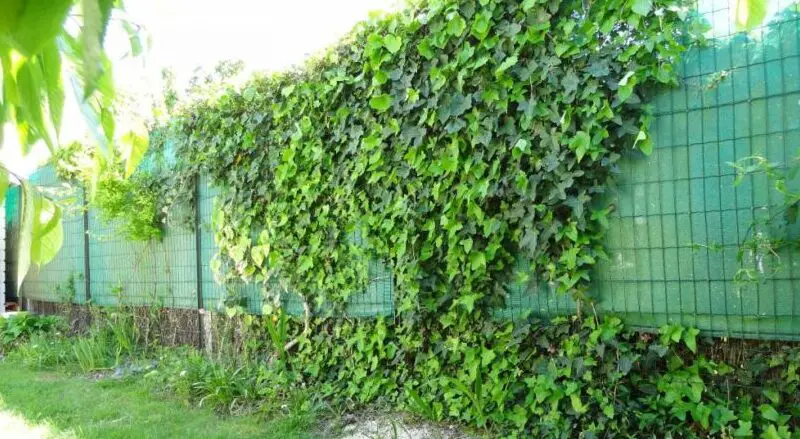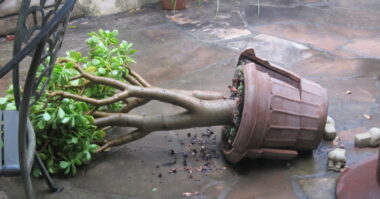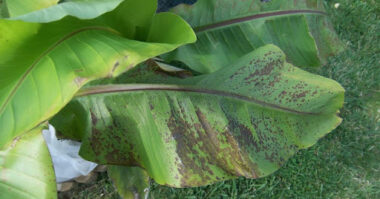If ivy is a symbol of fidelity, it is not for nothing! Its growth is very impressive and it can completely invade the garden even if it does some damage.
It is not easy to remove it, but there are unstoppable natural methods and tools adapted to this tough climbing plant. We explain how to get rid of it when it attacks a fence.
Contents
Eradicate ivy growing on fences
1. Adapted tools
To remove ivy climbing a fence, you will need: a pair of gloves, pruning shears, long-handled shears or a hatchet (if the ivy is resistant), a wire brush, a pickaxe and a garden hose.
2. Soften the branches
Moisten the ivy with a garden hose for easy removal. Start by spraying the top of the ivy with water and work your way down to the roots. The water will flow down to the ground and soften the hardest roots and trunk, making it easier to pull out.
3. Cut the main branch
To weaken the ivy, cut the main branch with your shears. It is advisable to cut it at both ends of the trunk to remove it more easily. Prune it at the base, near the roots and at the top, where the small branches leave. If the trunk is difficult to cut, chop it. Simply remove it with gloves.
4. Detach the ivy from the fence
When the main trunk is removed and the branches have been softened, you can remove the small branches from the fence by hand. Wear gloves and pull gently so as not to damage your fence. If a branch of ivy resists, cut it with pruning shears and remove it. Beware of insect nests hidden under the foliage that they particularly like!
5. Brush the fence
To avoid having to repeat this operation every year, gently brush the fence with a wire brush to loosen the remaining small suction cups. Take the ivy to the garbage dump because small black berries are poisonous.
6. Controlling its growth
You want to keep some of the ivy? Prune it regularly, preferably in autumn. Cut the branches with pruning shears and remember to remove the small suction cups.
7. Finish definitively
Prevent regrowth of climbing by following these two tips. First remove the roots. To prevent them from growing back, take a pickaxe and remove any roots you find. Then spray the soil with fertilizer. Spray weed killer on the fence after cleaning it so that it penetrates well into the unevenness.
If you don’t want to use chemical weed killer, make a natural one by putting five liters of water, one kilo of iodized salt and 200 ml of white vinegar in a large spray bottle. The acidity of the white vinegar protects and maintains the quality of the soil and the iodized salt prevents the regrowth of ivy.
Take the measure of the damage it can cause
Ivy can be a great asset in the garden, provided it is controlled. Otherwise, it can smother some plants and prevent other plants from growing because its foliage is toxic.
It can also damage a fence (coating that peels off, traces very difficult to remove …) and encourage pests on a balcony or terrace. Worse, it is not uncommon for it to attack masonry or lift roof tiles if it crawls along the walls of the house.
Weaken and cut the ivy
To get rid of ivy, first moisten it with a garden hose. By softening the branches, trunks and roots, you will be better able to detach it from its support. Use pruning shears, long-handled shears or a hatchet (depending on the thickness of the branches) and cut the main branch at the base, as close to the ground as possible.
Next, loosen the ivy gently (so as not to damage the support) starting at the top where the stems are less resistant. Take care to put on gloves to protect your hands from insects hidden under the foliage. Finally, gently brush the fence with a wire brush to remove the last suckers.
Use natural methods
There are grandmother’s recipes that have proven themselves!
- You can get rid of crawling ivy by sprinkling it with boiling water, possibly with a little bleach, or concentrated milk of lime. However, you will have to repeat the operation several days apart.
- You can also cover the roots with several kilos of coarse sea salt. Also think of preventing the reappearance of the plant by spraying a natural weedkiller on the fence after cleaning.
- You can make a natural weed killer yourself with water, iodized salt and white vinegar.
Summary
Ivy, like brambles, can quickly invade a garden. Ivy can take root on its own, even when it has been cut down. It must therefore be removed immediately. Roots can be destroyed by simply using boiling water with coarse salt or a little bleach.
Starch cooking water can also be used. Repeat the operation several times at intervals of a few days. However, the soil cannot be used for cultivation without rinsing it to remove salt residues.









